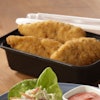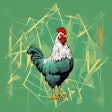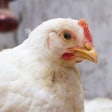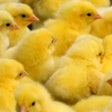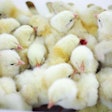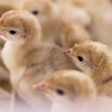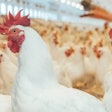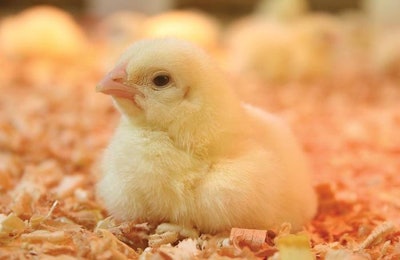
Broilers already grow at maximal rates due to advances in genetics and nutrition, but we still have room to improve feed efficiency, said Dr. Leonardo Linares, senior nutritionist at Aviagen, in a recent event on poultry nutrition sponsored by Hamlet Protein during EuroTier 2016.
When you think about it, the reason is rather obvious. Most of the factors affecting feed efficiency are related to the feed itself, and every nutritionist will agree with me in saying that we are still rather behind genetics in this aspect. So, the question that we shall strive to answer is: How do we improve feed efficiency beyond genetics?
What is feed efficiency?
Before we even attempt to improve feed efficiency, let us define what is and what is not feed efficiency. In practical terms, feed efficiency is the number of kilograms or pounds of feed consumed per kilogram or pound of body weight gain. This is the universal expression of feed efficiency, often termed feed conversion rate, or rather stylish in American nomenclature as FCR. But, that’s not all. The correct definition is gain/feed, as this is the term used by modern economics and scientific journals, but we shall ignore such details.
There is an increasing amount of evidence pointing toward the fact that an early boost in life leads to a more profitable broiler.
A more appropriate way of measuring feed efficiency is using the amount of energy consumed instead of feed consumed. This is because birds will tend to equalize energy intake when given feeds of varying energy concentration. Nevertheless, this more sophisticated definition is not as widespread as it should be, if only because most broiler diets contain comparable (but not equal) levels of energy.
Feed processing
In contrast to other monogastric animals, such as pigs, broilers do not benefit from finely ground feed. Birds have a unique capacity to soften up and “grind” their feed inside their gut, and trials with finely ground feed do not support an equal response as that seen in pigs. In fact, a very finely ground diet will impede feed intake as the floury feed will stick to beaks, making life miserable for the poor birds. This is not to say that we should be feeding whole cereals and soybeans (although there is such a nutrition program), but for normal feeding programs, a medium to coarse particle size is sufficient.
Cereal cooking also does not offer any benefits in terms of higher starch digestibility, such as seen in piglets. In contrast, thermal processing can neutralize many pathogens in the feed. This in turn will lead to a healthy gut environment, which in turn will lead to less nutrients being consumed by bacteria and absence of pathogenic gut disturbances that both lead to deteriorated feed efficiency. Finally, pelleting and crumbling will slightly improve feed efficiency as birds will consume more feed per day, thus growing faster and minimizing their maintenance expenditure in terms of feed requirements.
Additives that aid digestion
Although enzymes come to mind when we start talking about improving nutrient digestibility, their effect can be minimal. Granted, the right enzyme product can yield as much as 50+ kcal/kg metabolizable energy, but if left as such, that is without protein support, this extra energy will become body fat. Other additives that indirectly boost feed efficiency are those that increase, or rather maintain, good gut health and those that plainly kill bacteria.
In the first case, such additives will keep birds healthy, and healthy birds are allowed to express their full genetic potential. Here we need to mention that it is growth potential that drives feed intake; forcing unhealthy birds to consume extra feed only makes them more sick. The second class of additives that reduce the number of bacteria, good or bad, in the gut have a more direct effect. Bugs in the gut require nutrients to thrive, and because of that, their overgrowth robs nutrients that could have been used by the animal. After all, they are the first to come into contact with nutrients. And bacteria colonize not only the hindgut, but every part of the gut, albeit at different concentrations.
Energy density
We mentioned above that the real measurement of feed efficiency is energy and not feed mass consumed. If we desire to reduce the FCR in absolute terms (that is to improve feed efficiency measured as feed/gain), we can simply increase the energy density of the feed. If we increase feed energy density by 5 percent we should be able to observe a similar percentage drop in FCR. Here we assume a well-balanced diet and no effect in terms of weight gain. If we fail to observe such effect it is because diets are not properly balanced in terms of protein (most likely) or other nutrients (very rare). In fact, this exercise can be executed within certain limits. Too low an energy concentration and the birds will simply be unable to eat enough to satisfy their needs (feed becomes bulky); too high an energy concentration and the birds will overconsume feed to satisfy their need for satiety (becoming fat as they reach their daily protein deposition potential).
At this point, it merits mentioning that feed cost per kilogram or pound does not change proportionally to energy concentration. For example, an increase of 5 percent in energy concentration does not mean this feed will be 5 percent more expensive. If this would be the case, then matters would have been ideal. But, in most cases, feed cost increases slightly with each incremental step towards a more dense feed. There is a point where energy concentration becomes prohibitive in terms of cost per kilogram or pound body weight gain: the final arbitrator of profitability. Luckily, a qualified nutritionist can determine the optimal energy/nutrient density for a given set of ingredients based on their prices.
Super pre-starters
There is an increasing amount of evidence pointing toward the fact that an early boost in life leads to a more profitable broiler. This is a combination of increased health, improved feed efficiency and faster growth rates. As it happens, normal pre-starters are no longer sufficient for the needs of modern genetics. In fact, according to Dr. Linares, who inspired me to write this piece, nutrition lags behind in terms of advances compared to genetics. A super pre-starter, thus, is another tool to get better numbers, and perhaps even better profitability.
Read more about super pre-starters:
Highly digestible pre-starters for antibiotic-free broilers
Improving feed efficiency
Feed efficiency is measured the wrong way, but as they say on Wall Street: it is what it is. We can improve feed efficiency by using certain (but not all of them together) additives, give broilers an early boost and above all, something that is beyond the scope of this article, written by a nutritionist, is to ensure birds enjoy maximal health. Thus, make your vet your best friend long before you talk to your nutritionist.

